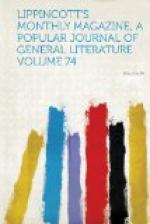The method of beginning their instruction is by means of simple familiar objects, or, where these cannot be obtained, illustrations of them. A picture of a horse is placed, at one end of the teacher’s blackboard. Instantly two fingers of each hand go up to the top of each little head. If it were a picture of an animal with longer ears, each would make an ass of himself. So far so good, only they do not know the name of this animal, familiar as they are with him. The teacher writes the name under the picture. The article “A” is also written, which, though it puzzles them, they must take on trust. It cannot be explained at this stage. The teacher then holds up an ear of corn. Of course they know that very well, and make the sign for it, shelling the fore finger. It is then laid upon the opposite end of the blackboard, and its name written under it. A short pause, with a glance first at the horse and then at the corn, soon brings out the sign for “eats,” which is written in its proper place, and the sentence is complete. The little “ignorants,” as they are dubbed by the older pupils, are then plunged head and ears into the task of learning to form the written characters as well as the construction of sentences. It is setting foot in an unexplored wilderness. No ray of light penetrates the darkness of that wilderness save the tiny torch just placed in their hands.




